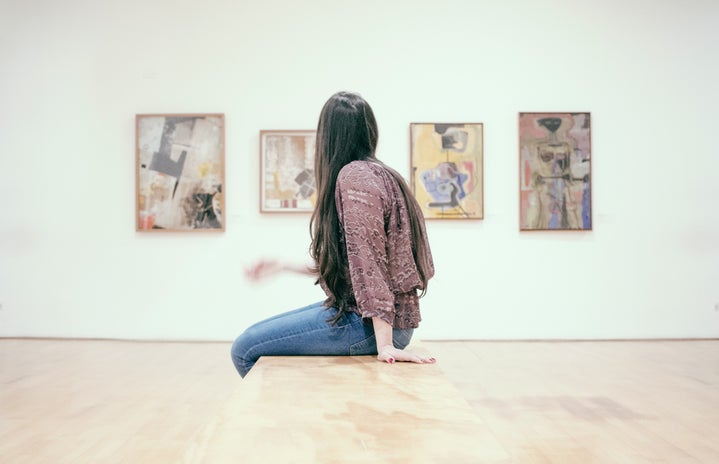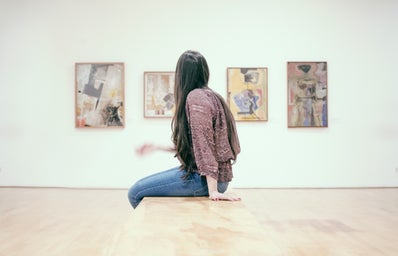For those who reside in St. Pete and have always wanted to go to the Metropolitan Museum of Art in New York City or to the Louvre in Paris to admire historically significant works of art, there is a much closer opportunity to admire pieces of equal caliber. The Dalí museum recently opened a new exhibit called Dalí and the Impressionists and it will be open until Apr. 28. It features works from important figures of the Impressionist movement including Claude Monet, Pierre-Auguste Renoir, Edgar Degas, Henri Matisse, and Paul Cézanne. The exhibit is organized by fundamental aspects of artistic works such as landscape and form. As such, the exhibit walks the viewer through Dalí’s personal exploration of Impressionism in his youth during the beginning of his artistic career. Works created by the figures of the Impressionist movement are placed in proximity to Dalí’s so the viewer can draw comparisons and view his source of inspiration. The Impressionist movement focused on capturing the fleeting moments and momentary glimpses of life itself, an idea that drew me into the exhibition as an artist. Impressionism in itself was a rebellion against the norm at the time, which was traditional painting and classical subject matter. As one experiences the exhibition, it becomes clear how a movement focusing on capturing the essence of a movement influenced Dalí, the artist who revolutionized surrealism.
Upon stepping foot into the exhibition, I was greeted with a wall featuring Antibes (Afternoon Effect) by Claude Monet with a quote by Dalí from 1920 and an arrow pointing to the right. It read, “I keep on admiring the great French Impressionists, Manet, Degas, Renoir. I wish they would become the strongest force of my life.” Then, I walked past the wall in the indicated direction and saw a wall with a short paragraph summarizing Dalí’s engagement with Impressionism and what the movement meant to him. On the left of this wall was a section of two walls dedicated to the atmosphere in the Impressionist movement, stating that “Impressionist artists sought to capture the atmospheric effects of a particular place and time.” While Impressionist artists were more drawn to places like L’Estaque, a fishing village, Dalí captured the beauty of his home, Catalonia. Atmosphere in Impressionism was characterized by “loose, visible brushstrokes and a vibrant, often unmixed palette.” As this is the very beginning of Dalí’s exploration of the movement, his experimentations become clear in works like Playa Port Alguer from Riba d’en Pitxot, where the Church of Cadaques is depicted in what is described as an “atmospheric haze of blues and grays.” Dalí’s inspiration was garnered from works like Renoi’s Rocky Crags at L’Estaque whose bold and loose brushstrokes create a hazy effect of objects moving in the wind while vividly depicting the rocky scenery. Additionally, this section features a diary from 1920 belonging to Dalí, who was 15 years old at the time, revealing the source of the quote from the very beginning.
The next section transitions from an inspiration within landscape to an exploration of portraiture. This work features an equal number of works made by Dalí and works created by important figures within the Impressionist movement, including Edward Degas and Paul Cezanne. It was organized by placing more of Dalí’s works towards the end, so the viewers get a sense of what Impressionist portraiture looked like. What I found most interesting was Dalí’s Study of a Nude, which shows a woman facing away from the viewer at a different angle. The most intriguing part was how Dalí employed cross-hatching, a textural technique more unique to graphite drawing, in an oil painting as a unique take on Impressionism. Portraiture of idealized subjects was a popular style for traditional painting, and classical subjects who were depicted in a rigid and realistic style were the very things that Impressionism rebelled against. However, Dalí’s exploration was not limited to Impressionism, as seen in the work Self-Portrait (Figueras). The figure is painted within an Impressionist style and has a long, almost metallic nose with a large eye. This subtle distortion of the human figure can be attributed to Dalí’s first touches of Surrealism, showing how he found interest in incorporating contradictory styles into a single piece. This is where we truly begin to see his roots, and where the renowned artistic style of Dalí’s works takes shape.
As I continued, I saw the next section tucked into another small hallway past the Atmosphere section, dedicated to Form. In art, form refers to all shapes and figures that are three dimensional, and in Impressionism, there is a particular attentiveness to the curves of forms that draw the viewer’s eye to a particular point in a piece. Alfred Sisley was an artist focused on curves in landscapes while Jean-Baptiste-Camille Corot, an artist who was “an important precursor to Impressionism,” largely focused on depicting female subjects. Dalí explored both approaches, but the one that stood out to me the most was Portrait of My Aunt. Interestingly, the loose brush strokes and vibrant color palette give the impression of a Monet painting rather than a work of Dalí. However, it is intriguing that his aunt’s face lacks any significant features that would make her an actual being, which could either be an Impressionist technique or a nod to Dalí’s personal life, as his aunt had become his step-mother at this time. This painting is contrasted with works from Corot and Pierre-Auguste Renoir, an artist who mastered textiles in an Impressionist style in his work Algerian Girl.
Once I left this section, I encountered a more open space that was dedicated to Impressionism as it related to more complex concepts like place, luminescence, and dramatic color. On the left, I saw Dalí’s work Cadaqués, which doesn’t seem to be Impressionist at first glance. However, he employs Impressionist techniques of capturing a landscape in its entirety, although the color palette, rigid brushstrokes, and geometric forms seem to disagree. Beside it is the title piece Antibes (Afternoon Effect) by Claude Monet, a piece that brilliantly encapsulates all that is Impressionism with its vibrant color palette, loose brushstrokes, and simple yet unblended style that captures the landscape and the emotion it evokes. The section dedicated to luminescence fascinated me the most, as Impressionists would use “small, visible brushstrokes to make an evanescent ‘impression’ of their subject permanent.” The artist Jean Baptiste Armand Guillaumin utilizes this efficiently in his piece Bridge in the Mountains where he maintains unity with brighter hues balanced with darker shades. Remarkably, his technique does not undermine the rest of the piece, a skill shared by many Impressionist artists. However, the Dramatic Color section perfectly encapsulates both the Impressionist movement and the turning point in Dalí’s career that led both him and the artistic community towards styles like Cubism and Futurism. The best way to summarize this section is Bouquet (L’Important c’est la rose) by Dalí, a work where he used a muted color palette with dramatic dark shadows and light hue to emphasize forms and present an integration of styles. Roses in a Glass Vase by Vuillard shows that different forms can still be accounted for despite the loose style of Impressionism. Dalí even acknowledged his abrupt shift away from Impressionism in the magazine L’Amic de les Arts when he said “[Impressionism] has passed, like all ancient art, into history.”
At the very end of this space is a section called “Your Portrait” where you can take a selfie and a machine will use AI technology to make your photograph into an Impressionist style image (which can be emailed to you for free). Though I didn’t try it out myself, I saw example images that were being displayed and wasn’t very impressed, since the AI was a little off and resembled a poorly photoshopped image instead. However, towards the exit, there was a wall of paintings by other important Impressionist figures and Dalí himself. This wall showcased the height of the movement while contrasting it with works that encapsulate Dalí’s engagement with the movement, the most profound being Portdogué, Cadaqués. This piece was made at the beginning of his career, the techniques of loose brushstrokes and bright colors still inspired from works such as View of the Seine at Herblay by Paul Signac. However, this work, alongside others that were made towards the beginning of Dalí’s artistic journey serves to remind us of his roots, and his ultimate inspiration in creating more notable works of art as he developed as an artist. As if to summarize everything that defines “inspiration” for Dalí, the exhibition ends with a large-scale photograph of the Sortell Beach at Cadaqués, almost allowing you to see Dali’s town from his perspective and inspiring you to perceive your surroundings in a way that is unique to you.
As an artist who is largely inspired by the Impressionist movement and its practices, I was very appreciative and intrigued to see an exhibition dedicated to Dalí’s engagement with the movement throughout the early stages of his career. Even if viewers are not acquainted with art history or Dalí’s history, there is something for everyone to enjoy. Impressionism as a movement is intriguing on its own, and I encourage those who are inspired by this exhibition to look into the artists and works displayed. From what I know, Impressionism and Surrealism seem to contrast each other initially, but after this exhibition, I’m starting to think that one was built off the other after all. Where one movement focused on capturing the fleeting moments of life, the lights and shadows of a landscape, and movement overall, the other focuses on the surreal aspects of perceiving a world broken by war. If this exhibition were to have a message, I think it would be to take something away from your surroundings and find inspiration from those who came before you. However, it is important as an artist to create something of your own, whether that be integrating several styles together or using one style to inspire another. The ultimate idea is that our perceptions are never limited, and we should strive to capture each moment, each second in time, in our own way.


